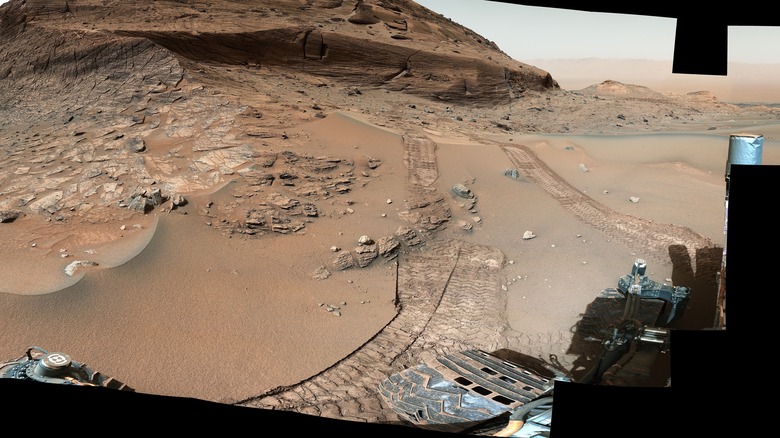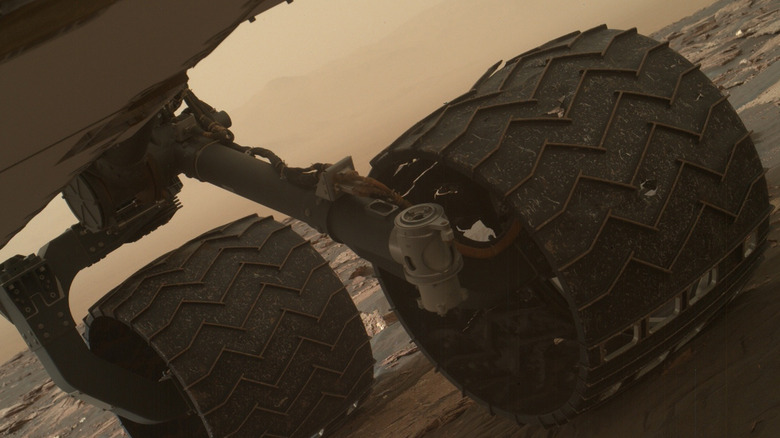How A Software Update Could Help The Curiosity Rover Travel Across Mars Faster
As advanced as the robotic rovers which explore Mars are, one thing that might surprise you is how slowly they travel. The NASA Curiosity rover, for example, has a top speed of less than 0.1 mph, far less than the typical human walking speed of 3 mph. Even though it could theoretically travel more than one hundred meters in a day, it typically travels just a few hundred meters per month.
That's because the drivers who control the rover are very careful with it, avoiding any hazards which could potentially damage the rover — being especially aware of potential harm to its wheels, which are already damaged from its 11 years of travel across the Red planet. They need to avoid obstacles like large boulders and potential dangers like sharp rocks named gator backs for their rough surfaces, while still visiting sites of interest like climbing up the steep slopes of Mount Sharp, also known as Aeolis Mons, a mountain located within the crater whose layers represent millions of years of deposits.
Making plans for driving the rover is a balance between wanting to visit new and exciting locations within the Gale Crater, where Curiosity is based, for the sake of scientific interest, and trying to preserve the rover's hardware so it can keep going for as long as possible.
In April 2023, though, NASA's Jet Propulsion Laboratory uploaded a new software update to Curiosity which should enable it to drive faster, while reducing the wear on its wheels. The update is based on the software used by Curiosity's young sibling, the Perseverance rover.
How the new software will help Curiosity drive faster
The Perseverance rover, which was launched nine years after Curiosity, has more advanced software which has a particular feature called thinking while driving which allows it to perform a certain amount of driving autonomously, or by itself. The rover uses an auto-navigation system called AutoNav which takes images from its cameras to build up a 3D map of its environment, then plans a route to avoid obstacles. This software still needs human drivers to oversee the routes it plans out, but the system allows Perseverance to travel much faster: 120 meters per hour compared to Curiosity's 20 meters per hour. Curiosity has its own, older version of AutoNav, but now it has been upgraded with new software to make it quicker.
"This won't let Curiosity drive as quickly as Perseverance, but instead of stopping for a full minute after a drive segment, we're stopping for just a moment or two," said Curiosity's engineering operations team chief Jonathan Denison. "Spending less time idling between drive segments also means we use less energy each day. And even though we're almost 11 years old, we're still implementing new ideas to use more of our available energy for science activities."
Perseverance has the advantage of a special dedicated computer for its autonomous navigation, which is why it can still travel faster. Curiosity doesn't have a dedicated computer, so it will still need to stop to process images of the terrain, but now it can do this processing faster.
Keeping Curiosity roving
Even though the software has been working well on Perseverance, the Curiosity team wasn't going to upload it to their rover without thorough and careful planning. After all, there are no tech repair shops on Mars and the emphasis is always on keeping the rover as safe and healthy as possible to allow it to continue for a long mission.
As well as the updated Autonav software, the update included a total of 180 changes, each of which had to be planned and accounted for. The rover itself also had to stop all science operations between April 3 and April 7 2023 to get the software loaded.
This is the first update to Curiosity's software since 2016, and the team has been working on all of the many software tweaks for years. "The flight software is essential to our mission, so this is a big deal for our team," said Kathya Zamora-Garcia, Curiosity Project Manager. "This is a major software update, and we had to make sure we did it right."
With the update now complete, everything seems to be working just fine and the team can breathe a sigh of relief. "The idea of hitting the install button was a little scary," Denison said. "Despite all our testing, we never know exactly what will happen until the software is up there."

